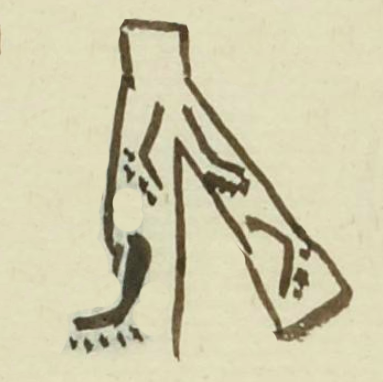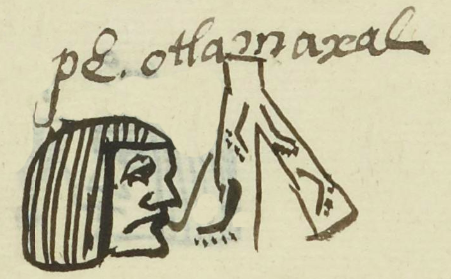Otlamaxal (MH658v)
This black-line drawing of the compound glyph for the personal name Otlamaxal (“The Fork in the Road”) shows an upside-down Y (something forked, maxalli) in a road (otli). Each leg of the road has two alternating footprints suggesting movement over a landscape. It is a bird’s eye view.
Stephanie Wood
The term for crossroads is similar to the term for the human crotch (maxactli), which also lends itself to bifurcation of various kinds, such as a confluence of rivers. See some examples below.
Footprint glyphs have a wide range of translations. In this collection, so far, we can attest to yauh, xo, pano, -pan, paina, temo, nemi, quetza, otli, iyaquic hualiloti, huallauh, tetepotztoca, totoco, -tihui, and the vowel "o." Other research (Herrera et al, 2005, 64) points to additional terms, including: choloa, tlaloa, totoyoa, eco, aci, quiza, maxalihui, centlacxitl, and xocpalli.
Stephanie Wood
1560
Jeff Haskett-Wood
caminos, cruces, nombres de hombres

otlamaxal(li), crossroads, https://nahuatl.wired-humanities.org/content/otlamaxalli
maxal(li), something forked, https://nahuatl.wired-humanities.org/content/maxalli
maxac(tli), fork in the road or human crotch, https://nahuatl.wired-humanities.org/content/maxactli
Encrucijada
Stephanie Wood
Matrícula de Huexotzinco, folio 658v, World Digital Library, https://www.loc.gov/resource/gdcwdl.wdl_15282/?sp=397&st=image
This manuscript is hosted by the Library of Congress and the World Digital Library; used here with the Creative Commons, “Attribution-NonCommercial-ShareAlike 3.0 License” (CC-BY-NC-SAq 3.0).






